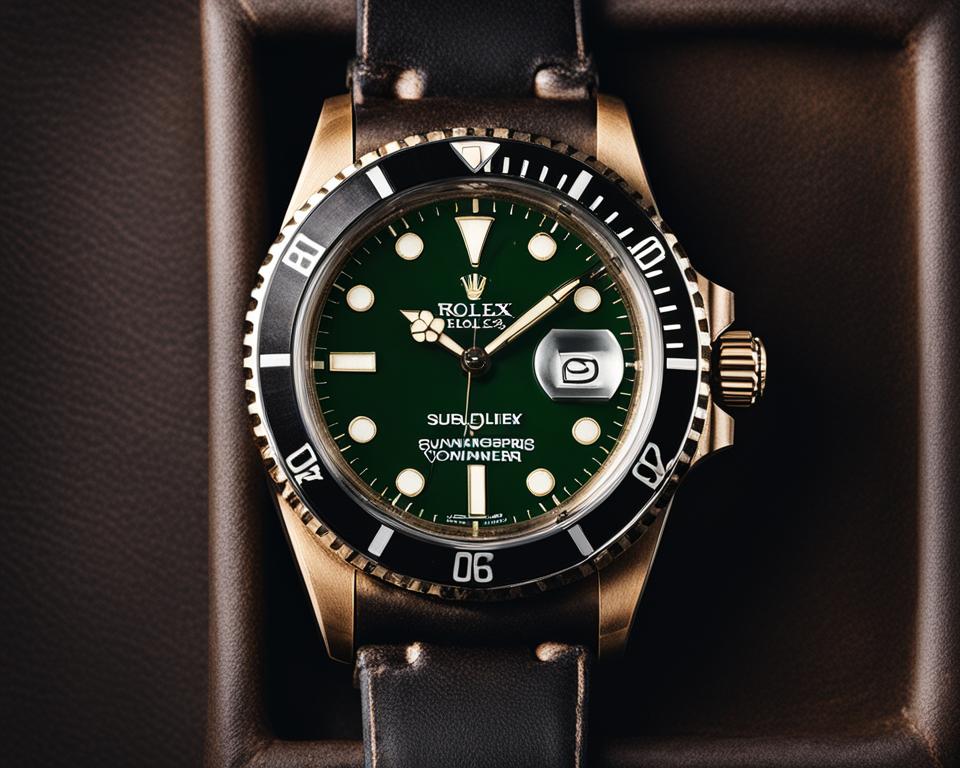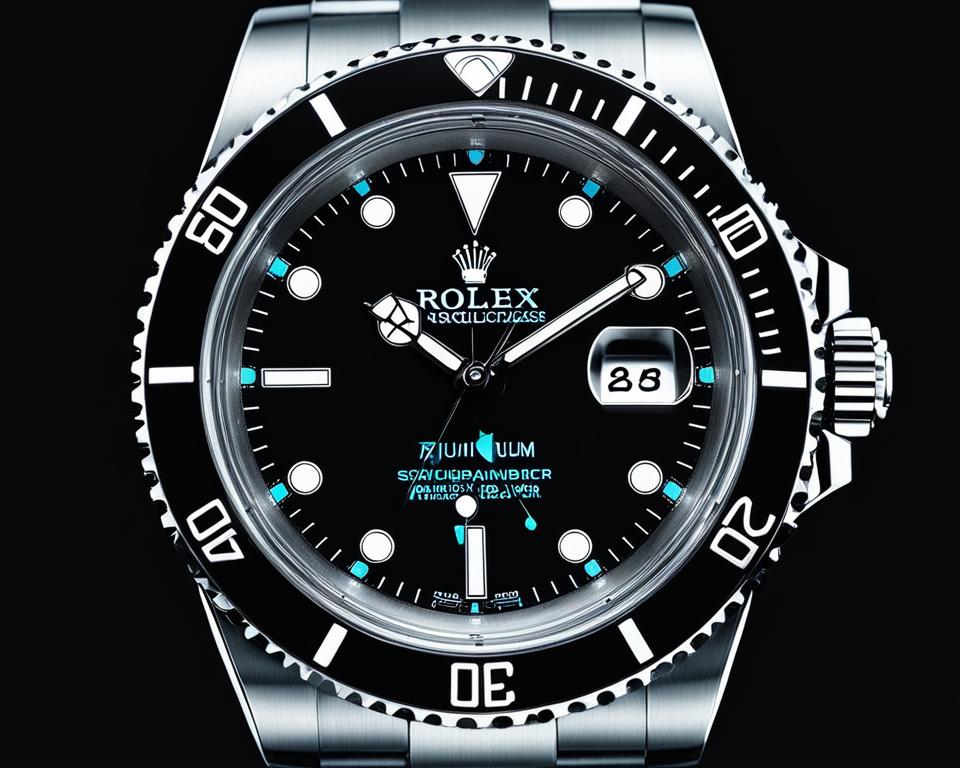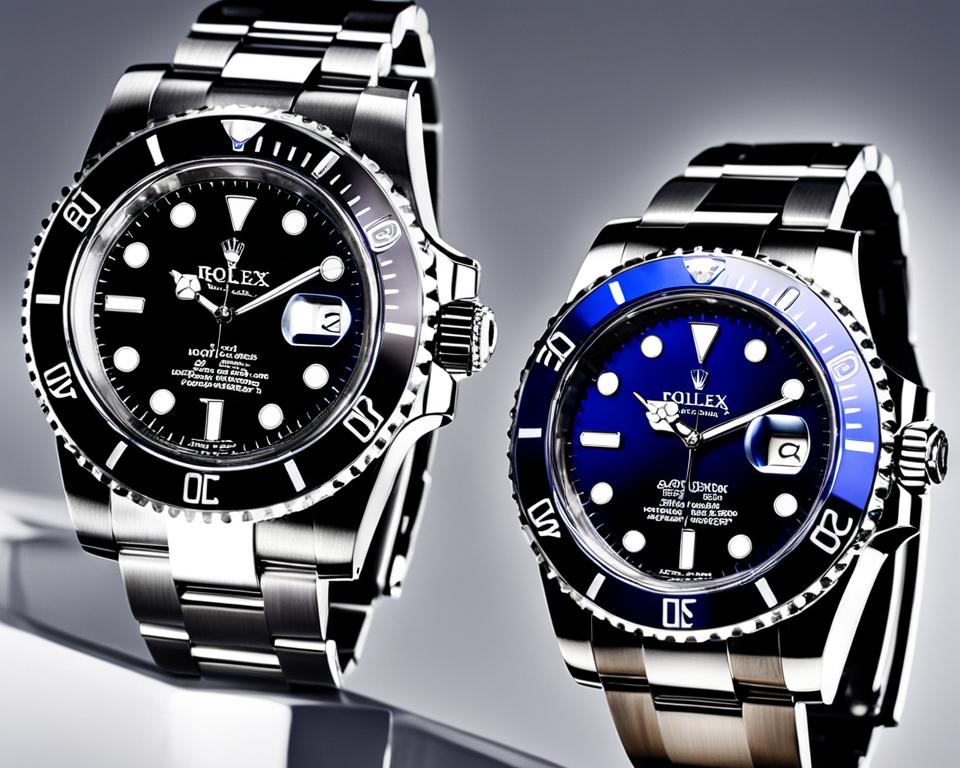The Rolex Submariner is renowned for its exceptional luminosity, making it a preferred choice among divers and watch enthusiasts alike. The luminous markers and luminescent hands on the Submariner model ensure clear legibility, even in the darkest depths of the ocean. This article explores the fascinating world of luminosity in Rolex watches, from the early days of radium to the modern breakthroughs in lume technology.
Key Takeaways:
- The Rolex Submariner is known for its impressive luminosity, providing unmatched readability in underwater conditions.
- Luminous markers and luminescent hands on the Submariner model enhance visibility in low-light environments.
- Rolex has pioneered the use of various luminous materials throughout its history, including radium, tritium, Luminova, Super-Luminova, and Chromalight.
- Chromalight, Rolex’s proprietary luminescence technology, offers a longer-lasting blue glow for increased readability.
- The Submariner’s luminosity is a testament to Rolex’s commitment to engineering excellence in Swiss luxury watches.
The Evolution of Luminous Materials
Rolex, renowned for its impeccable craftsmanship, has continuously evolved its luminous materials to ensure superior readability and functionality. Let’s take a closer look at the journey of luminous materials used by Rolex over the years.
Radium: A Radiant Start
In the early 1900s, Rolex introduced radium as its first luminous material. This radioactive substance emitted a green glow and provided excellent luminescence in low-light conditions. However, the health risks associated with radium led Rolex to search for safer alternatives.
Tritium: A Safer Glow
In the 1960s, Rolex transitioned from radium to tritium, a less radioactive material. Tritium maintained the characteristic green glow of its predecessor and offered improved safety. Rolex marked tritium dials with indicators of radioactivity levels and tritium markings, ensuring transparency and providing vital information to collectors and enthusiasts.
The Advent of Luminova
In 1998, Rolex embraced a groundbreaking photoluminescent paint called Luminova, replacing tritium. Luminova excelled in brightness and longevity, offering enhanced readability even in the darkest depths. This non-radioactive material required prior exposure to light to charge its luminescence.
Super-Luminova: Illuminating Brilliance
Building upon the success of Luminova, Rolex introduced Super-Luminova in 2000. As a Swiss-Made variant, Super-Luminova exhibited heightened brightness and a prolonged afterglow. It offered up to four hours of luminescence after sufficient exposure to light, proving indispensable for divers and adventurers.
Chromalight: A Modern Marvel
In a significant leap forward, Rolex introduced Chromalight in 2008, solidifying its commitment to pushing the boundaries of luminescence technology. Chromalight replaced the green glow with a captivating blue brilliance, providing exceptional legibility in low-light environments. This proprietary compound produces a long-lasting glow of up to eight continuous hours, empowering wearers with unwavering clarity.
| Luminous Material | Glow Color | Brightness | Longevity |
|---|---|---|---|
| Radium | Green | High | Short |
| Tritium | Green | Moderate | Moderate |
| Luminova | Green | High | Long |
| Super-Luminova | Green | Very High | Extended |
| Chromalight | Blue | Very High | Extended |
Note: The table above provides a comparison of the different luminous materials used by Rolex, emphasizing their respective glow colors, brightness levels, and longevities.
Radium: The Early Years
Rolex watches have long been admired for their exceptional craftsmanship and attention to detail. A key aspect that sets Rolex apart is their luminous paint, which enables their timepieces to glow in low-light conditions. However, this wasn’t always the case. In the early years, Rolex used a luminous material called radium.
What is radium?
Radium is a radioactive element that emits a faint, eerie glow. It was discovered by Marie and Pierre Curie in 1898 and quickly gained popularity for its luminous properties. Rolex began incorporating radium into their watches in the early 1900s, making them highly legible in the dark.
The dangers of radium:
While radium provided an excellent luminous effect, its usage came with significant health risks. Radium is highly carcinogenic, meaning it has the potential to cause cancer. The prolonged exposure to radium resulted in several watchmakers, including Rolex, experiencing health issues, such as radiation burns and even death.
Rolex’s decision to discontinue radium:
Concerns about the carcinogenic effects of radium eventually led Rolex to seek safer alternatives. In 1963, Rolex made the responsible decision to discontinue the use of radium on their watches, prioritizing the health and well-being of their customers and employees.
As a result, vintage Rolex watches from the early 1900s to 1963 may still contain traces of radium. These timepieces hold historical significance and are sought after by collectors due to their rare and unique nature.
Radium vs. Modern Luminous Materials
Let’s take a closer look at the key differences between radium and the modern luminous materials used by Rolex today. The table below provides a comprehensive comparison:
| Radium | Modern Luminous Materials |
|---|---|
| Carcinogenic effects | Safe and non-radioactive |
| Limited duration of luminescence | Long-lasting glow |
| Radioactive nature | Non-radioactive |
| Health risks to watchmakers | Improved safety for employees |
| Rare and collectible | Accessible and widely used |
It is clear that Rolex’s transition from radium to modern luminous materials has not only enhanced the safety of their timepieces but also improved the overall longevity and brightness of the luminescent effect.
The evolution of Rolex’s luminous materials is a testament to their commitment to innovation and advancement. By continually pushing the boundaries, Rolex has created timepieces that not only exemplify exceptional design but also prioritize the well-being of their wearers.

As we move forward, it’s crucial to reflect on Rolex’s journey from radium to the safe and highly efficient luminous materials used today. By understanding the historical context, we can better appreciate the remarkable timepieces that Rolex continues to produce.
Tritium: A Safer Alternative
After discontinuing the use of radium, Rolex turned to tritium as its luminous material of choice for Rolex watches. Tritium is a radioactive substance that emits less radiation than radium, making it a safer option. One significant advantage of tritium is its shorter half-life, which means it decays at a faster rate, reducing the risk of long-term exposure.
However, despite its improved safety profile, tritium luminescence is not without its challenges. Over time, tritium markings on Rolex watches age and discolor, creating unique patinas that enhance the vintage appeal. This natural aging process is often embraced by collectors and enthusiasts as a testament to the watch’s history and adds character to the timepiece.
Rolex took measures to ensure that tritium dials and markings were clearly identifiable. The brand marked tritium dials with indicators of radioactivity levels and tritium markings. These markings not only exemplify Rolex’s commitment to safety and quality but also help in distinguishing tritium-lumed watches from their radium-lumed counterparts.
Exploring the evolution of Rolex luminous materials allows us to appreciate the advancements made in ensuring both luminosity and safety in their timepieces. From the early radium days to the modern Chromalight, each era has contributed to Rolex’s legacy of exceptional watchmaking, unwavering quality, and innovation.
Aging and Discoloration of Tritium
The aging and discoloration of tritium luminescence on vintage Rolex watches is a fascinating phenomenon. Over time, the tritium material breaks down, resulting in changes to the color and intensity of the luminescence. This natural aging process is influenced by various factors, including exposure to light, humidity, and wear.
As tritium ages, its luminescence shifts from a vibrant white to a creamy yellow or beige hue. The unique patina that develops adds depth and character to the watch, creating a visual display of the watch’s journey through time. Collectors often prize these patinas as they signify the watch’s history and contribute to its overall desirability.
It’s worth noting that the aging and discoloration of tritium on Rolex watches is a gradual process that occurs over several decades. Therefore, it is more common to find vintage Rolex watches with tritium luminescence showing signs of aging than those with pristine, untouched luminescence.
Tritium Markings and Safety Indicators
Rolex took comprehensive measures to ensure the safety of tritium-lumed watches and to provide clear indications of their radioactivity levels. Tritium dials were marked with the word “T Swiss T” or “Swiss T ,” indicating the presence of tritium luminescence. These markings served as aesthetic enhancements while also informing wearers about the type of luminous material used on their timepieces.
Focusing on safety, Rolex added a small radioactive symbol just below the six o’clock marker to indicate the presence of a radioactive substance. This symbol acted as a visual reminder to handle tritium-lumed watches with care and to ensure compliance with recommended disposal guidelines. The iconic tritium markings on vintage Rolex watches symbolize a chapter in watchmaking history reflecting the brand’s commitment to quality, innovation, and safety.
| Advantages of Tritium | Challenges of Tritium |
|---|---|
| 1. Safer alternative to radium | 1. Aging and discoloration over time |
| 2. Embraced by collectors for the unique patinas | 2. Requires clear markings to indicate radioactivity |
| 3. Shorter half-life reduces long-term health risks |

Luminova and Super-Luminova: Non-Radioactive Advancements
In 1998, Rolex introduced Luminova, a breakthrough in the world of luminous materials. This non-radioactive photoluminescent paint replaced the previously used tritium, offering improved longevity and brightness. Luminova required exposure to light beforehand to activate its luminosity, ensuring a vivid and long-lasting glow without the worry of radiation exposure.
Building upon the success of Luminova, Rolex introduced Super-Luminova in 2000. This Swiss-Made version of Luminova further enhanced the aesthetic and functionality of Rolex watches. Super-Luminova provided a glow that lasted up to four hours, charged by exposure to light, and maintained its brightness even in the darkest conditions. With this advancement, Rolex established itself as a pioneer in safe and reliable luminescent materials.
Chromalight: The Modern Marvel
In 2008, Rolex introduced Chromalight, their proprietary luminescence technology. This cutting-edge innovation revolutionized the readability of Rolex watches in low-light conditions. Unlike the previous green hues, Chromalight emits a mesmerizing blue glow, enhancing visibility and clarity.
One of the standout features of Chromalight is its longer duration of luminescence. Rolex watches equipped with Chromalight can provide up to eight continuous hours of luminosity, ensuring legibility even during extended periods of darkness. This extended glow is a testament to Rolex’s commitment to excellence and continuous improvement.
What sets Chromalight apart from other luminous materials is that it is produced in-house by Rolex. This in-house production ensures stringent quality control and meticulous attention to detail, ensuring the consistent and exceptional performance of Chromalight on each timepiece.
FAQ
What is the significance of luminosity in the Rolex Submariner?
The luminosity of the Rolex Submariner ensures unmatched readability in the depths of the ocean, making it one of the best dive watches available.
What types of luminous materials has Rolex used over the years?
Rolex has used various luminous materials throughout its history, including radium, tritium, Luminova, Super-Luminova, and their proprietary Chromalight technology.
When did Rolex stop using radium as a luminous material?
Rolex discontinued the use of radium in 1963 due to concerns about radiation exposure.
Why did Rolex switch from radium to tritium?
Rolex switched to tritium as a safer alternative to radium because it emits less radiation and has a shorter half-life.
What are the unique characteristics of tritium luminescence on vintage Rolex watches?
Tritium luminescence fades and discolors over time, creating unique patinas on vintage Rolex watches. Rolex marked tritium dials with indicators of radioactivity levels and tritium markings to distinguish them.
How did Rolex further improve their luminous technology after tritium?
Rolex replaced tritium with Luminova, a non-radioactive photoluminescent paint, in 1998. Later, they introduced Super-Luminova in 2000, which is a Swiss-Made version of Luminova with enhanced brightness and longevity.
What is Chromalight, and when was it introduced?
Chromalight is Rolex’s proprietary luminescence technology introduced in 2008. It provides a blue glow that offers superior readability in low-light conditions compared to previous green hues.
How long does Chromalight glow, and how is it produced?
Chromalight has a longer-lasting glow of up to eight continuous hours and is produced in-house by Rolex.

Leave a Reply